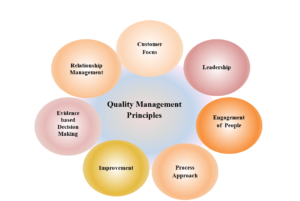ISO 9001
Benefits of ISO 9001 Implementation
When to Apply for Certification
An Overview of ISO 9001 Requirements
Introduction
ISO 9001 is an international standard that specifies the requirements for implementation of a Quality Management System (QMS) in the organizations that intend
to demonstrate their abilities to continuously provide conforming product/ service with customer, legal and regulatory requirements. This standard is the most popular in ISO 9000 series and is the only standard for which the organizations can receive certificate.
Benefits of ISO 9001 Implementation
By implementing ISO 9001, organizations ensure that they continuously provide quality product/ service to their customers and in return, gain some advantages including the satisfaction of customers, stakeholders and employees.
Since ISO 9001 specifies the requirements of an effective quality management system, it help organizations to:
- Organizing a quality management system
- Clarification of business strategies
- Business risk management
- Achieving customer, top management and employees’ satisfaction
- Continual improvement of business processes
- Cost saving
ISO 9001 certification will improve the organization’s image in the target market and increase its credibility with its customers and assures them that the realization of the expected quality of product/service is subject to a systematic structure, and therefore its continuity and improvement is inevitable and also essential.
When to Apply for Certification
Organizations interested in ISO 9001 standard certification should prepare the documentation structure in accordance with the requirements of the standard and provide adequate and appropriate evidence of the implementation of these requirements.
Since in certification contract, a specific period of time is defined for conducting the third party audit at the organization’s site, the organization has to ensure the availability of the followings as a minimum:
- Scope of quality management system and related operational sites
- Internal and external issues affecting the quality management system
- Process map, interactions and sequence of business processes (implementation of a process approach)
- Required procedures and documentation as mentioned in ISO 9001
- Legal and regulatory requirements related to the product/service and also customer requirements
- Records of system implementation for at least 2 months
- Internal audit and management review records
An Overview of ISO 9001 Requirements
ISO 9001 is based on the implementation of the PDCA methodology (Plan-Do-Check-Act). In addition, process approach is used to document and revise organizational structure, responsibilities and procedures required to achieve an efficient quality management system. Certain sections of the standard contain information on many titles, including:
- Risk based thinking and analysis of business environment
- Requirements of a quality management system including documented information, and process approach
- Management responsibility and role of leadership
- Resource management including human resources and workplace environment
- Product/ service realization from design to delivery and post-delivery activities
- Measurement, analysis and improvement of QMS through internal audits and implementation of corrective/ preventive actions
Quality management has 7 principles:
1- Customer focus
Sam Walton (founder of Wal-Mart):
“There is only one boss. The customer. And he can fire everybody in the company from the chairman on down, simply by spending his money somewhere else.”
This principle is focused on customer satisfaction and loyalty building.
As customers have unlimited access to social networks in general, they can express their dissatisfaction or delight and be heard by all, right away. This can either ruin an organization’s reputation or, just the opposite, give it an opportunity for unpredictable success.
For this reason, the organization shall identify and even anticipate its customers’ expectations and do its bets to ensure that the offered product / service meets these expectations or even surpass them.
2- Leadership
Dwight Eisenhower:
“Leadership is the art of getting someone else to do something you want done because he wants to do it.”
It is expected that top management set quality objectives, provide the required resources for achievement of them and engage the employees. In this way the organization have the road map and means to achieve its purpose.
3- Engagement of people
Benjamin Franklin:
“Tell me and I forget. Teach me and I remember. Involve me and I learn.”
For the effective staff involvement, they have to be competent and feel valued. To put it into practice, the employees shall have the required personal and organizational skills and their initiatives shall be recognized and awarded appropriately.
4- Process approach
Aimé Césaire:
“A civilization that proves unable to solve the problems that its functioning creates is a decadent civilization.”
For implementation of a process approach, the organization shall identify the inter-related activities and data flow within departments and divisions. A process is defined as any activity or sets of activities that use resources to transform inputs to outputs.
This approach helps the organizations deal with the various activities, manage their resources, monitor their needs and achieve their objectives in a structured way.
5- Improvement
Albert Einstein:
“Life is like riding a bicycle. To keep your balance, you must keep moving.”
The organization shall constantly improve itself at least to maintain its performance levels, or ideally to make progress. Improvement can be achieved in product quality, customer satisfaction, process performance, risks reduction and so on.
6- Evidence based decision making
Euclid:
“What can be asserted without evidence can be denied without evidence.”
It suggests that making the best decisions is possible through using all the available evidences to reduce the degree of uncertainty. In this way, decisions making based on feeling, intuition, or instinct are replaced by objective data, facts and figures.
7- Relationship management
Jiddu Krishnamurti:
“Relationships are the mirror in which we discover ourselves.”
The interested parties are all actors who influence or are influenced by the activities of the organization that include shareholders, employees, suppliers, banks, regulators, and so on.
Effective and timely communication with these interested parties to understand their requirements plays a great role in performance improvement of the organization.


